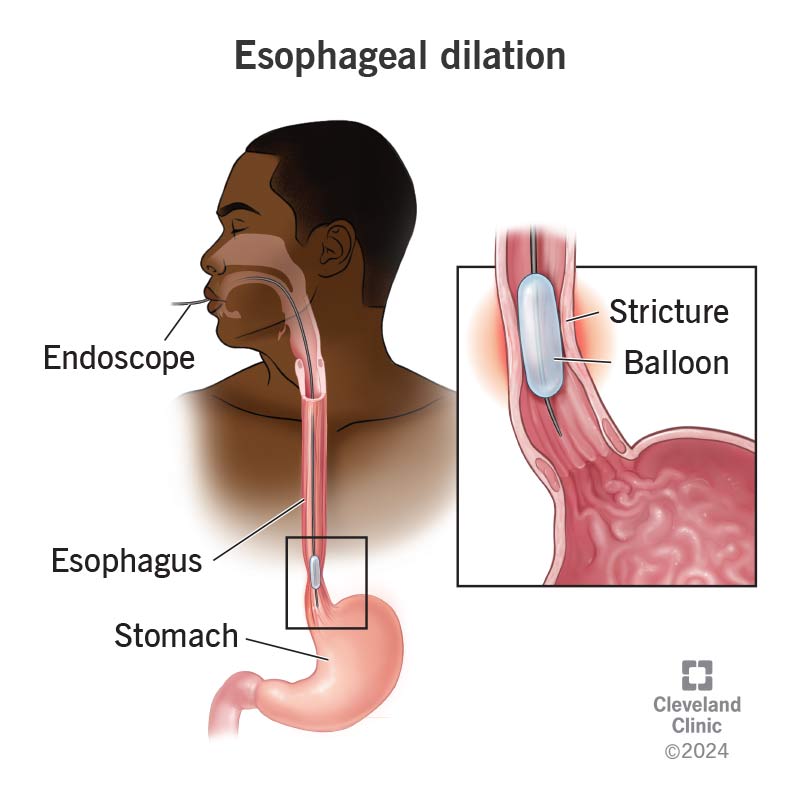Esophageal dilation is an outpatient procedure that stretches your esophagus to make swallowing easier. Healthcare providers use it to treat conditions like esophageal strictures and achalasia. Esophageal stretching has a high success rate, but you might need more than one session to achieve desired results.
Advertisement
Cleveland Clinic is a non-profit academic medical center. Advertising on our site helps support our mission. We do not endorse non-Cleveland Clinic products or services. Policy

Esophageal dilation (eh-sof-uh-JEE-uhl di-LAY-shun) is a procedure that stretches (dilates) your esophagus (swallowing tube) so food can pass through easier.
Advertisement
Cleveland Clinic is a non-profit academic medical center. Advertising on our site helps support our mission. We do not endorse non-Cleveland Clinic products or services. Policy
You might need esophageal dilation if you have symptoms like:
One procedure may be enough to solve the issue, but it’s common to need multiple dilations. How many treatments you need depends on the severity of your condition.
There are a lot of alternate names for esophageal dilation, including “esophageal dilatation” and “esophagus stretching surgery.” Some people may even call it throat stretching surgery. But this isn’t entirely accurate because a healthcare provider stretches your esophagus, not your throat.
Healthcare providers use this procedure to treat esophageal conditions like:
Advertisement
Before your procedure, your healthcare provider will review your medical history and ask about any recent illnesses. Be sure to tell them about any medications you take. This includes prescription and over-the-counter (OTC) medications, as well as vitamins and supplements.
You’ll also need to have an empty stomach. Your healthcare provider will give you a list of presurgical instructions, including when to stop eating and drinking the night before. Be sure to follow these guidelines closely.
Healthcare providers use various methods for esophageal dilation. Each uses a slightly different device, but the approach is generally the same:
Balloon dilation is the most common approach for stretching your esophagus. But healthcare providers may use bougie dilation to treat multiple strictures. If you have an unresponsive esophagus, or severe esophageal strictures, your provider might recommend multiple procedures to stretch your esophagus to a bigger size each time.
Esophageal dilation is an outpatient procedure. It usually takes about 15 minutes to complete.
Esophageal dilation can give you fast relief from swallowing issues. While you might need a repeat procedure in the future, relief usually lasts for months (or sometimes years). Some people will never need another dilation.
Esophageal dilation is a relatively safe, low-risk procedure. It can successfully treat more than 90% of all esophageal strictures.
Complications are rare, but may include:
Most people can resume normal routines the day after the procedure.
Esophageal dilation is minimally invasive. But you might still develop uncomfortable side effects like soreness in your throat or behind your breastbone.
These side effects are normal and should go away in a few days. It’s a good idea to have some softer foods on hand, like gelatin, pudding, yogurt and mashed potatoes. Your healthcare provider will also tell you if you need to be on a liquid or soft food eating plan after the dilation.
Advertisement
Tell your healthcare provider whenever you feel like something isn’t quite right. Let them know if you notice:
Esophageal conditions like strictures, rings and achalasia can interfere with everyday routines. When it hurts to swallow, you might (consciously or subconsciously) eat or hydrate less often than you should. Esophageal dilation gently stretches your esophagus, so foods and liquids go down more easily. It’s a low-risk procedure with a high success rate. But you might need more than one treatment to achieve your desired results. Ask your healthcare provider if esophageal dilation could improve your quality of life.
Advertisement
Swallowing disorders (dysphagia) can affect how you eat and drink. Cleveland Clinic is here to help you manage your dysphagia and feel better.

Last reviewed on 10/28/2024.
Learn more about the Health Library and our editorial process.